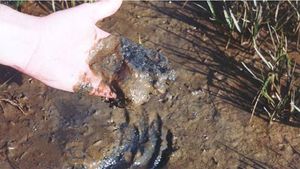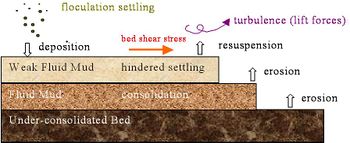Difference between revisions of "Mud"
(→The biological component: fecal pellets) |
(→Yield strength) |
||
| Line 58: | Line 58: | ||
| − | where & | + | where Δρa (Δρa) = excess aggregate density. This equation is not valid for flocs with biological constituents, thus it is less useful in the natural environment. |
| − | |||
===Settling velocities=== | ===Settling velocities=== | ||
Revision as of 10:57, 29 January 2007
Cohesive Sediments
- Particle Size. Silt: 2-63mm. Clay: less than 2mm
- Ionic charges: Interact electrostatically.
- Organic material influence sediment properties
- Strong sediment-fluid interaction (flocculation, turbulence damping etc.)
This text is taken from Karen Edelvang (1995) "The significance of aggregation in an estuarine environ¬ment." PhD thesis printed in Geographica Hafniensia A5 ISBN 87-87945-18-5
The nature of flocculation
Flocculation is governed by a number of processes that all influence the nature of the single particles forming part of the floc or aggregate.
Mineralogy
Flocs are an assemblage of minerals normally representing varying minerals and grain sizes. Particles of clay minerals are the major con¬stituents in flocs. The mineralogic composition of these particles plays a role in the process of flocculation. The most resistant material in the aquatic environment is quartz, which is found in all particle fractions down to less than 2 μm. Quartz has no cohesive properties and does not take part in the flocculation processes directly, but might well be part of aggregates originating from fecal pellets. Especially in spring, algal blooms lead to a large input of diatoms thus giving high concentrations of silicate in the suspended matter. The most abundant inorganic material found in suspension is weathered products of mica and feldspars. The most common ¬clay minerals are kaolinite, illite and montmorillonite. Quartz particles may also be suspended under rough turbulent conditions.
Kaolinite is a dimorphic (1:1 layers) mineral constituting of a silica (tetrahedral) sheet and an alumina (octahedral) sheet. Illite and montmorillonite are trimorphic (2:1 layers) with two silica sheets sand¬wiching an alumina sheet .
Chemical properties of clay particles
Clay particles have plate-like features and an overall negative ionic charge due to broken mineral bonds on their faces. This means that in a solution the negatively charged clay particles are attracted by positive electrodes. The internal balance in a solution, which has no net electric charge, is internally compensated for by the electric double layer. The double layer consists of the negative clay particle charge and the equivalent amount of cationic charge attracted by the clay particle and accumulated in the liquid near the particle surface[1]. The accumulated cations around the clay particle are called counter-ions.
Brownian Motion
The Brownian motion is the irregular motion of any particle in suspension. The Brownian motion is caused by the thermal motion of water molecules colliding with the particle thus changing its direction randomly. Increased particle size means that the Brownian motion become less vivid as more kinetic energy is required to set the particle in motion or change its path.
The Brownian motion leads to the suspended particles randomly approaching one another until their counter-ions interfere. Consequently the particles repel each other. The amount of work involved in this repulsion is the repulsive potential, Vr, also called the Coulombic force[2] decreasing exponentially with the distance between the particles. Particles in saline water tend to flocculate and form large aggregates in spite of the repulsive forces still present.
Size distribution of single particles
Size distribution of suspended matter varies according to the environment. Clay particles act as colloids, defined as particles mainly less than 2 μm with large surface areas per unit mass[3]. They are chemically active because of their broken mineral bonds causing isomorph substitution in the crystal lattice. Normally the size range of the single particles forming the flocs is between less than 2 μm up to 20-30 μm thus in the clay- and silt-frac¬tion.
The different minerals seem to have limited and differing size ranges in the natural environ¬ment as shown by Gibbs[4]. This is of im¬portance when looking at the sorting, which na¬turally takes place in the estuarine environ¬ment[4].
The biological component: fecal pellets
Benthic organisms tend to modify cohesive sediment characteristics. Individual particles are ingested and form large, low density fecal pellets with settling velocities much higher than the individual particles contained in them. Estuarine sediment transport conditions are altered e.g. by change of bed roughness due to deposition of fecal pellets or by biological activity in the surface layers causing either binding or destabilizing of the bed surface[5].
Density, size and settling velocity of fecal pellets are important in describing sediment transport processes[6]. Fecal pellets are low density feces from suspension-feeding and mud-ingesting marine and estuarine benthic animals including oysters, worms, and barnacles. They consist of large amounts of fine sediments mainly single particles in the 1-5 μm range[7] and flocs ingested by the feeding animal, compacted in the gut and excreted as large aggregates glued together by mucus. Up to 25 % of the deposited sediment may in some areas originate from biodeposition.
Aggregate properties
Flocculation is governed by increasing concentration in a suspension. Aggregates tend to be more fragile the larger they become having lower densities, yield strength and viscosity allowing them to break up more easily. Flocs are stated to be self-similar in structure regardless of size. Thus the basic structure of the individual element is thought to be geometrically repeated in a hierarchial process. The fractal dimension is described by a value, D:
D = lnm1/lnm2
where m1 = the number of primary particles in a fixed structure, m2 = the factor by which the size of the aggregate increases. D is found to vary between 1 for polarized particles, 1.8 for flocs formed by collision to 2.1 for particles flocculating in suspensions with no electrolyte dissolved. Flocs with D > 2 are compact in structure, flocs with D < 2 are more fragile.
Yield strength
Yield strength is an important parameter in the description of mud properties. Several attempts have been made to describe the phenomenon. Kranenburg[8] suggests yield strength γy (σy) of a floc independent of size to be:
where Δρa (Δρa) = excess aggregate density. This equation is not valid for flocs with biological constituents, thus it is less useful in the natural environment.
Settling velocities
Migniot (1968)[9]locculation and hence floc settling velocity as one of the three basic physical properties of suspensions. Flocs and fecal pellets have physical properties which separate them from single particles. It is often argued that settling velocity rather than shape or equivalent fall diameter should be used to describe aggregates. However, it is difficult to measure settling velocity in situ. The only ordinary and inexpensive means so far is the settling tube originally developed by Owen (1971); later modified to the bottom withdrawal method.
References
- ↑ Van Olphen H (1963) An introduction to clay colloid chemistry. Interscience Publishers (John Wiley & Sons) pp 301
- ↑ Dyer (1986)
- ↑ Edzwald JK & O'Melia CR (1975) Clay Distribution in Recent Estuarine Sediments. Clay and Clay minerals, Vol 23 p 39-44
- ↑ 4.0 4.1 Gibbs RJ (1977) Clay Mineral Segregation in the Marine Environment. Journal of Sed Pet, Vol 47, p 237-243
- ↑ Nowell ARM, Jumars PA & Eckman JE (1981) Effects of biological activity on the entrainment of marine sediments. Mar Geol 42, p 133-153
- ↑ Taghon GL, Nowell ARM & Jumars PA (1984) Transport and breakdown of fecal pellets: Biological and sedimentological consequences. Limnol Oceanogr Vol 29(1), p 64-72
- ↑ Haven DS & Morales-Alamo R (1972) Biodeposition as a factor in sedimentation of fine suspended solids in estuaries. Geol Soc Mem, Vol 133, p 121-130
- ↑ (1994)
- ↑ Migniot C (1968) Etude des propriétés physiques de differents sediments trés fins et de leur comportement sous des actions hydrodynamiques. Houille Blanche 7 p 591-620
See also
External links
Author: Karen Edelvang, DHI, 1995. kae@dhi.dk.

